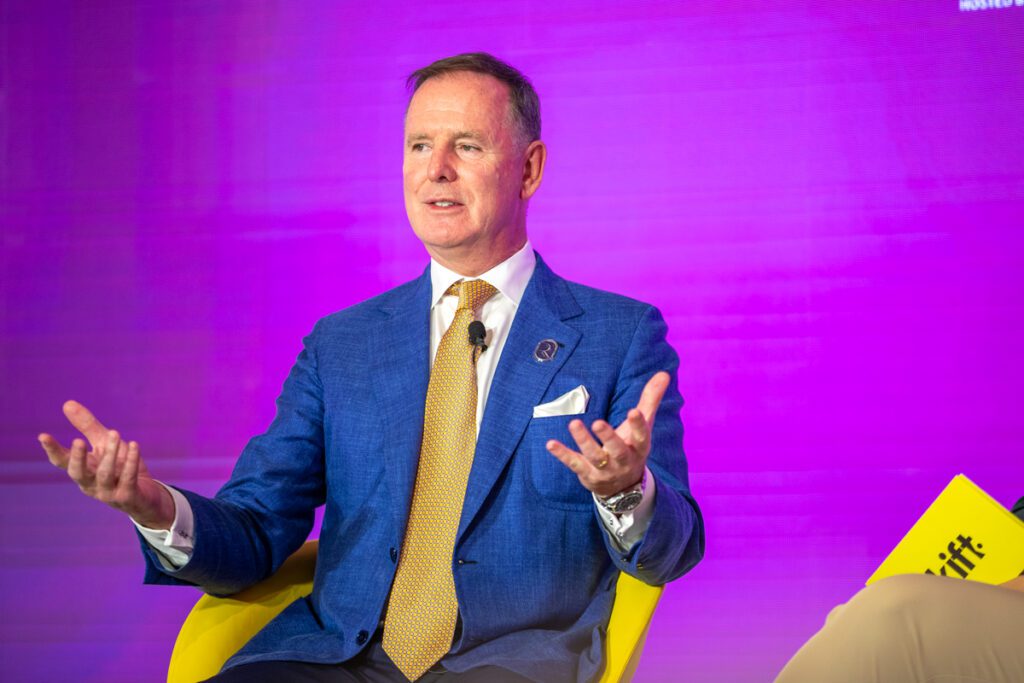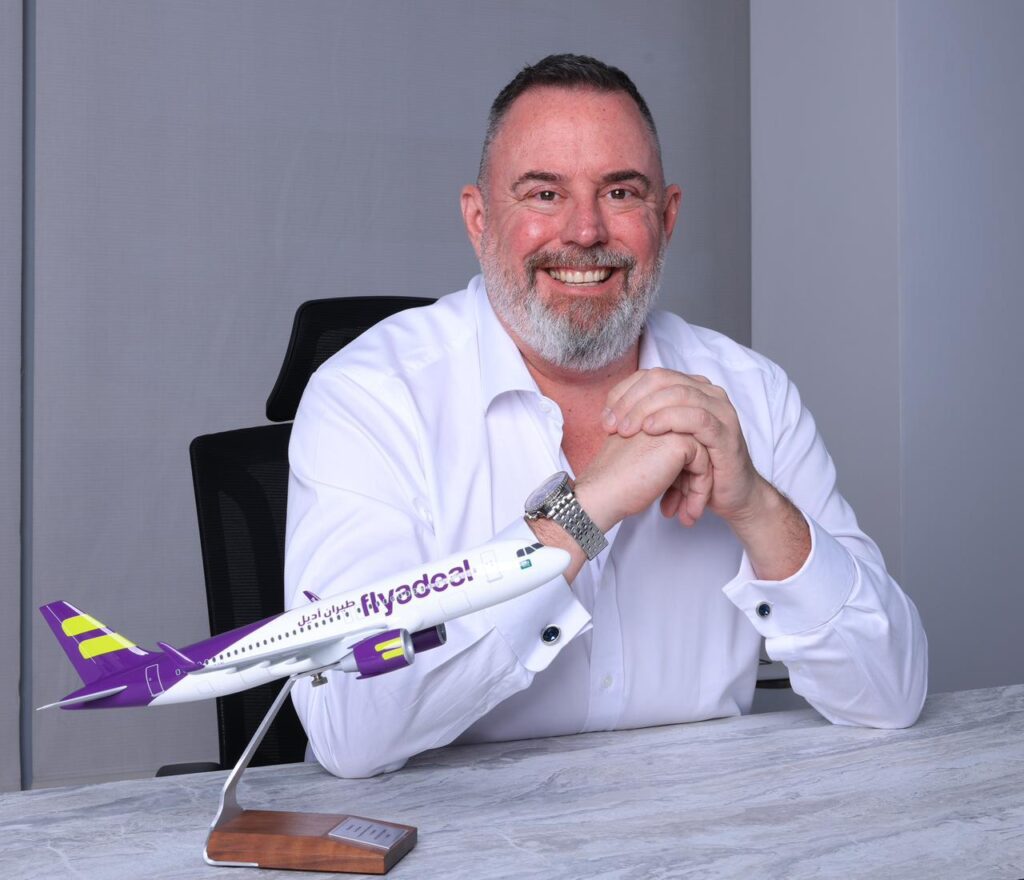From mammoth aircraft orders to innovations in passenger experience, the Middle East is playing a key role in reshaping the global aviation landscape. So when airline leaders from the region speak out, it’s usually worth paying attention.
At the Routes World 2024 conference – where airlines, airports, and tourism agencies gather to define the future for global air networks – Skift heard from four of the Middle East’s industry heavyweights. Here are some of the highlights:
Riyadh Air Ramps Up
The CEO of new Saudi carrier Riyadh Air said the airline is “well advanced” in obtaining its Air Operator Certificate (AOC). This is a key regulatory milestone required to begin commercial operations. Tony Douglas, the former Etihad chief tasked with making the start-up airline a reality, offered the update ahead of its planned launch in 2025.
Douglas said the carrier was “days away from completing its AOC flights” and would complete the all-important certification by the end of 2024. “Riyadh Air will be up and running and selling tickets next year,” he confirmed.
It follows the start of non-revenue test flights in September between Riyadh and Jeddah using a leased Boeing 787 aircraft from Saudia Airlines.
Douglas revealed that the firm’s digital offering will be presented in an “Apple-style” product launch at the end of October. The CEO also confirmed that the company recently moved into its new headquarters next to Riyadh’s international airport.
What Will Riyadh Air Fly?
Last year, Riyadh Air signed a blockbuster deal for up to 72 Boeing 787-9 Dreamliner planes. Of this, 39 are firm orders, with options to acquire a further 33 widebody aircraft. Despite a target of launching operations in June 2025, the airline has yet to reveal the composition of its narrowbody fleet. Commenting on a possible gap in the launch plan, Douglas said: “We will announce in relatively short order our position on narrowbodies, but it will be a fleet of roughly equivalent scale.
“We will start with widebodies and will deploy the 787-9 for example to one of the capital cities in western Europe from Riyadh. It will then do one of the thick, regional routes from Riyadh, like Delhi, Jeddah, or Dubai, so we can keep the utilization of our most valuable asset as high as possible.”
Riyadh Air plans to take delivery of its first narrowbody aircraft within a year of its launch with long-haul aircraft, Douglas added.
The carrier has agreed partnerships with several international airlines, including Delta Air Lines and Singapore Airlines. Douglas told delegates that he expected another two agreements to be reached. One with a Western European airline and another with an operator on the Indian subcontinent. Both deals will be in place before the first Riyadh Air-branded aircraft takes to the skies next summer.
Oman Air Undergoing ‘Immediate Surgery’
Oman Air is in the middle of a huge restructuring that has forced it to downsize its operations, at least in the short term. The hope is that this will help secure a more stable financial future.
As part of the plan, the airline is focusing on reducing costs and streamlining routes, culling some city pairs that were “high volume routes, but with… terrible yield”, CEO Con Korfiatis said, with the aim of becoming profitable.
The comprehensive restructuring plan, aimed at putting the airline on a surer footing, has seen cuts to routes and a scaling back of its fleet. Notably, this included the withdrawal of all of its Airbus A330s – a sweeping move that reduced its widebody count by around 50%.
The move was seen as essential for long-term growth, allowing the carrier to safeguard its position in an increasingly competitive Gulf market.
Despite the cutbacks, Korfiatis insisted Oman Air is committed to expanding its network in key regions in the future. “We need to justify our existence. We have to earn the right to continue to be the flag carrier,” he said in a blunt assessment of the carrier’s recent past.
“The losses had grown to a level where we needed to do immediate surgery. The work has started, by 2027 we hope to achieve financial security. We reduced our network substantially because the amount of money we were losing on some routes was just too high. The end game is not to be a smaller airline; the end game is to shrink, fix the foundations, and then go back to a growth agenda.”
Firing the starting gun on that ambition, Korfiatis revealed that Oman Air would be launching a new route in December between Muscat and Rome. Korfiatis highlighted a new stopover package that encourages transit passengers to break up their journey. The program is helped by a simplified and integrated hotel and flight booking system.
Air Arabia CEO: ‘Egypt Has a Lot of Potential’
Low-cost carrier Air Arabia has its sights set on growth outside its traditional markets in the Middle East. It will use a 120-strong aircraft order to achieve this, according to group chief executive officer Adel Abdullah Ali.
The budget brand’s fleet has grown by around 20% in the last year. It now stands at 88 aircraft, with a geographical spread across the Middle East and North Africa, from Casablanca in Morocco to its main base in Sharjah, UAE.
Speaking at the Routes event in Bahrain, Ali said that within the next decade, he hoped to have “many more hubs,” adding that “as long as it is not adding complexity to our business” he would consider forming additional non-Arabian subsidiaries. This could be in the model of Pakistan’s Fly Jinnah, a low-cost carrier owned and operated jointly by Air Arabia and Pakistan conglomerate Lakson Group.
“We will always go where we need to go,” he said. “The plan is organic growth; Egypt has a lot of potential that we have not tapped yet. With Fly Jinnah, we saw that there was a great opportunity, a country with 240 million people, a lot of people from Pakistan live outside the country, and it is a huge market with good potential.”
Opportunities to look further afield will be aided by the expected arrival of the Airbus A321XLR (extra long range) into Air Arabia’s fleet in 2027. Ali said this would be used to connect its hubs in the Middle East and North Africa with destinations deeper into Asia.
He also raised the prospect of transatlantic routes opening up with the extra-long-range variant, though cautioned: “At the moment, we have absolutely no plan to go across the Atlantic, [but] with the aircraft’s capability, it could go.”
Flyadeal CEO: ‘The Band-Aid has Been Ripped Off’
The CEO of Saudi low-cost carrier flyadeal shared ambitious plans to more than double its fleet size over the next four years. This will see the company transform from a largely domestic operator to one with much greater international connectivity.
Steven Greenway, who was appointed CEO in January, said: “The Saudi market is booming, the band-aid has been ripped off. The real emphasis for the aircraft coming in will be spreading our wings internationally.”
That will encompass “everything from southeast Europe to the subcontinent of India”, said Greenway, who added that “anywhere within five hours of Saudi” was up for grabs.
That is a fundamental shift for a carrier that today has a route network comprising 80% domestic destinations within the Kingdom and only 20% which are international. “By the end of next year that will be 65% domestic, 35% international,” he said.
Flyadeal currently operates a fleet of 35 aircraft. The airline aims to expand to 88 planes by 2028, in line with Saudi Arabia’s Vision 2030 objectives to boost tourism and domestic travel.
To help achieve the target, Greenway revealed the company is “examining widebody options”, and will announce the chosen aircraft type – either the Boeing 787 or the Airbus A330 – by the end of the year.
He said both had their advantages. The 787 has fleet commonality with stablemate Saudia Airlines, while the A330 would be a faster transition for its pilots who are already trained on the airline’s fleet of A320 family aircraft.
In May, Greenway spoke exclusively to Skift about his ambitions to triple the size of the airline by the end of the decade.
Watch Riyadh Air CEO, Tony Douglas at the Skift Global Forum East 2023:
Airlines Sector Stock Index Performance Year-to-Date
What am I looking at? The performance of airline sector stocks within the ST200. The index includes companies publicly traded across global markets including network carriers, low-cost carriers, and other related companies.
The Skift Travel 200 (ST200) combines the financial performance of nearly 200 travel companies worth more than a trillion dollars into a single number. See more airlines sector financial performance.


